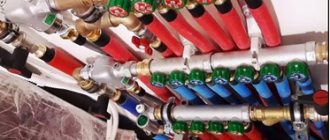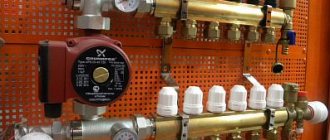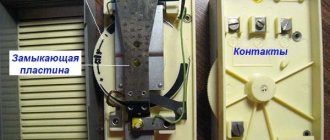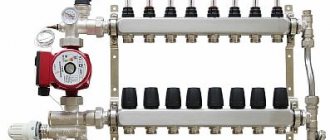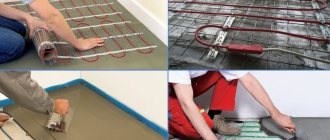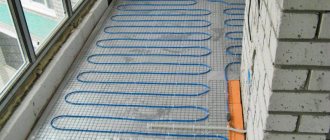Today, in order to make living conditions in the house more comfortable during the cold season, most owners install water-heated floors. But even with proper design and installation of the system, it is not always possible to achieve a comfortable microclimate in the apartment.
The reason lies in incorrect adjustment of the heating system. Therefore, it is important to understand how to properly set up a water-heated floor.
For your information! The advantage of individual heating structures is the ability to regulate the optimal thermal level at minimal costs.
Optimal temperature parameters
Setting up a water heated floor is carried out depending on individual needs. Some people like it when the room is warm, while others prefer invigorating freshness, even in the most severe frosts. But despite this, there are general standards that were developed taking into account sanitary standards, these include:
- floor heating up to 28 degrees;
- if there is another heat source or if you live indoors permanently, the ideal level is from 22 to 26 - these are optimal conditions for a person;
- if this type of heat source is the only one, or it is located in the bathroom, corridor, balcony, or in a house where people do not live permanently, it is permissible to raise the degree to 32.
Therefore, when regulating water floors, in addition to your preferences, so that the microclimate in the apartment is healthy, you should take these standards into account.
Some useful information about electrical wires
Inside the box you need to insert several wires with different insulation colors. According to the standards, zero is blue, and phase is black. The ground wire is painted in two colors - yellow and green.
To determine the phase, you should use an indicator screwdriver. In addition, at the time of preparation, before installing the floor heating regulator, you should check the voltage in the network. Ideally, it is as close to 220 volts as possible.
Next you will need to cut the main heating cable and the power cable. To do this, it is best to use a sharp knife or special nippers. You need to cut it so that the cables protrude from the mounting box by about 50 mm. Next, the wires are stripped.
If the model provides screwless cable fastening, then the stripping length is determined based on the recommendations indicated on the device body. Be careful not to let the stripped cables touch each other. It is best to connect the ground wire to the heating cable braid by soldering or a terminal.
After this, the power cable is connected to the mounted thermostat. Instructions on how to install a thermostat for a heated floor are indicated by the manufacturer either on the body or in the manual. The instructions may vary slightly between similar models, so the diagram must be studied in each individual case individually.
Connect the wire with the phase and secure it to the desired contact in the device; it is usually marked with the letter L. The terminal for the neutral wire is marked N. However, you should be careful, as there are types of systems in which the N terminal is intended for connecting the main heating cable. This nuance needs to be studied separately with special care.
Types of heating cables:
- A two-core heating cable hides two current-carrying conductors under its protective insulation. This type of cable is considered more convenient than its single-core version, because it is connected to the thermostat only at one end. In such a cable there are 3 wires nearby, two of which are conductive and one is grounding.
- A single-core cable has only one conductive wire, usually white.
Connection diagrams
Water-heated floors often act as an additional source of heat. It is mainly combined with a general heating system or hot water supply. The specifics of adjusting heated floors depend on the connection method.
There are several schemes for connecting water heating devices.
Combined
A popular and technologically justified method is combined heating, which includes a radiator and a heated floor system. However, to arrange this structure we will need:
- boiler;
- pump;
- expansion tank;
- collectors for radiators and heated floors;
- radiators;
- pipes.
It is important to correctly combine different heating devices so that they function effectively. The main methods of connecting radiators with warm water floors into a single structure:
- Parallel connection of the collector unit to the heating system. The circuits cut into the highway up to the batteries. Liquid circulation is provided by a pump.
- Connection via rings, primary or secondary. When laid, the pipeline forms rings; they cut into the supply system in several places. The coolant temperature depends on the distance of the coil from the heat source.
- Connection to a coplanar manifold, to its extreme point. Water moves in the circuit due to the operation of a common house pump located in the generator room. In this case, the warm floor has priority when supplying hot coolant.
- Using a hydraulic distribution unit is an excellent option: if there are several heating devices, with differences in the length of the floor loops and the water flow in them. In this scheme, you also cannot do without a coplanar collector.
- Local connection of the circuit through a unibox in a parallel circuit. Suitable for rooms with a small area: bathroom, corridor.
Connection to radiator
A common way to recharge underfloor heating is from radiators. With this scheme, the temperature of the liquid in the water floor is directly related to the degree of its heating in the radiator.
Find out the maximum and optimal coolant temperature in an underfloor heating system.
To build this system, you need a main line that has a supply and return, as well as floor pipes and a unibox. Since the water in the radiators heats up to 80 degrees, it is recommended to connect the floor loops to the return line.
Unibox - device, types and principle of operation, advantages of use, do-it-yourself installation.
From the boiler
This is a simple option - the installed boiler is intended only for heating water for heated floors, so no regulators are needed.
If you have a modern gas boiler, it is able to regulate the temperature itself; just set the required indicator on the panel. Even with a two-contact system, when the boiler heats water for radiators and heated floors, the values for each device can be easily adjusted by the boiler’s automatic system.
When using a boiler that runs on solid fuel, a compensating barrel is required. The level of temperature and pressure is regulated by installing a safety unit on the barrel, which consists of a pressure gauge, an air release valve and a thermostat.
For your information! The functioning of a water heated floor is affected by the pipe laying pattern - find out what laying patterns there are, as well as how to connect heated floors. With a “snake”, the heating will be uneven, with cold and hot areas. When the circuit is placed according to the “snail” pattern, uniform heating is ensured.
Using thermostats
To avoid overheating of the system, when installing a heated floor, a thermostat is installed - a small device that regulates the temperature. There are three main types of thermostats: electronic, mechanical and programmable. All of them differ from each other not only in names and prices, but also in technical characteristics. Therefore, when choosing a product, it is necessary to consult with a specialist.
Types of thermostats for heated floors
After purchasing a thermostat, you need to install it correctly. Below are step-by-step instructions for installing a regulator and a special temperature sensor, if followed, even a beginner can cope with this task. First, you need to make a small groove in the wall for laying the wire about the temperature sensor. Next you need to follow the instructions.
Connecting the heated floor controller
Step 1. Pass the wire with the temperature sensor through a corrugated tube (the diameter of the corrugation is selected according to the size of the wire).
Thread the wire into the corrugated tube
Step 2. Carefully remove the sensor wire from the other side of the corrugation.
Pull the wire out the other end
Step 3. Close the sensor end of the tube using a special plastic plug. This is required to protect the tube from dust and construction mixture.
Install the plastic plug
Step 4. Fix the end of the corrugated tube with the sensor between the heating circuits. For this purpose, it is advisable to use a special tape or durable clamps made of plastic.
Secure the end of the tube
Step 5. Lead the tube from the regulator to the floor, or rather, into a pre-prepared groove. Make sure that there are no strong bends in the tube.
Route the pipes to the floor
Step 6. After installing the wiring and a special corrugated tube, seal the groove in the wall with cement mortar. The surface should then remain smooth and level.
Mask the groove with mortar
Step 7: Clean and tin the wires well. The functioning of the thermostat will depend on the quality of the work done.
Tin the wires
Step 8. Connect the thermostat to the wires, and then install the device in its place. To do this, you need to make a hole in the wall to fit the dimensions of the regulator.
Connect the wires to the thermostat
Step 9: Test all electrical connections to ensure they are working properly. After checking, turn on the floor heating system for a short time. This is necessary to check the functionality of the system.
This is what the installed thermostat looks like
Step 10. If everything is fine and the floor heating system is working, then the light on the thermostat, or rather on its panel, will light up. The performance of the entire system will also be indicated by the heating of the floor surface. The diagram shows the installation location of the temperature sensor.
Example of a heated floor scheme
Temperature
The operating principle of a water heated floor is different from the functioning of other heating devices. The main difference is in the level of heating of the coolant. Water heated to 80 degrees is supplied to the radiators; for water floor circuits, a maximum of 42 degrees. At this temperature, the heating of the floor covering will reach 26 degrees.
There are two methods for adjusting the temperature of water heated floors:
- Carrying out control at the collector supply unit by mixing waste water. This is achieved by equipping a three-way valve with a thermostatic head. During operation, the temperature of the water, not the air, is taken into account, and a constant volume of liquid consumed is ensured, with a slight fluctuation in its temperature.
- By limiting the flow of heated coolant into the pipes. This also requires a thermal head, this is placed on the three-way valve and is used to stop the return flow. In this case, the supply and return taps are connected to the bypass, through which the flow is adjusted using a limiting valve. Since heated floors are inert, water is supplied to the pipes at a nominal temperature, and only its consumption changes.
In both methods, the thermostatic head operates based on the return temperature.
Minimum
The temperature of the floor covering directly affects the comfort of people using a particular room. This also affects their health. That is why experts do not recommend that floor temperatures fall below the following values:
- In living rooms - below 18 degrees Celsius.
- In the kitchen - below 18 degrees Celsius.
- In the toilet - below 18 degrees Celsius.
- In a shared bathroom or bathroom - below 18 degrees Celsius.
- In the corridor - below 16 degrees Celsius.
- In the lobby or stairwell - below 14 degrees Celsius.
- In the pantry - below 12 degrees Celsius.
Thus, it is necessary to ensure a temperature regime in all of the above rooms that exceeds the indicators indicated in the list.
Important At what temperature does the floor freeze? If water flows through the pipes, then it is necessary to maintain the temperature of the coolant above zero, otherwise the pipes will simply freeze. The best option is to use antifreeze as a coolant, then you can be calm at temperatures down to -65 degrees Celsius.
Rules for refueling the system
It is impossible to correctly configure the functioning of a water structure if the volume of liquid in the pipeline changes independently. This can happen if there is air in the system - see the instructions on how to bleed air from a heated floor yourself. Therefore, it is important to both professionally install the structure and fill it correctly.
To ensure high-quality filling of the system, both collector branches should be equipped with automatic air vents. Refilling of floor hinges should be carried out separately from other heating devices. The generator and radiators are filled in advance. Before refueling, the manifold inlet valves are closed.
To properly start the floor, you need to connect a hose from a water supply source or pump to the supply valve, and a hose for air outlet to the return valve.
You need to start filling the water floor from the collector and its distribution units. To do this, the flow meters of the supply valve are opened fully, at which point the return taps should be turned off.
The loops are filled one by one, water is released until it comes out of the bleed hose clean and without air bubbles. The water should be started with low pressure, this will make the process of air leaving the pipes more even. After threading all the loops, the device can be turned on.
Working with Manifold Flow Meters
Balancing a warm floor means determining the standards for each loop. After all, depending on the size of the floor branch, in order for the coolant to cool down according to the calculated value while passing through it, the amount of water required varies. The volume of liquid that the loop passes through is the thermal load on it.
It is often recommended to determine the coolant flow rate based on the power of the pump, that is, the volume of incoming liquid is divided proportionally by the length of the loops. However, you should abandon this method, since it is not easy to accurately calculate the size of each coil using this method.
In addition, calculations using this method lead to a discrepancy between the pressure in the loop and the calculated value, which makes it impossible to adjust the design.
The adjustment process with flow meters itself is simple - an article with step-by-step instructions. The throughput of the device is adjusted depending on the model, either by turning the body or the stem using a key. The device displays the amount of water in liters that has passed per minute; you just need to set the desired value.
Basically, when adjusting the capacity of one loop, a change occurs in the others. Therefore, the process should be repeated sequentially with each flowmeter. Significant failures indicate that the fittings have poor flow capacity, or the circulating pump has low performance.
How are servos connected?
In practice, different connection schemes for servomotors are used, which depends on the type of thermostat being installed. When this device controls only one heating circuit, it is connected by wires directly to a specific servo drive. If a multi-zone thermostat is used, then the wires are connected to specific terminals.
When all heating circuits are in the closed position, the command is received to turn off the circulation pump. This method is convenient if you plan to install an automatic heating boiler.
As for systems with solid fuel boilers of conventional design, the pumps are not allowed to be turned off, otherwise the heating structure will explode. In this case, install a bypass and a bypass valve, which is adjusted to a pressure value slightly lower than the maximum pressure of the circulation pump.
After reaching the desired value in the system (if a small number of heating circuits remain open), the bypass valve begins to partially wrap the coolant into the return pipe and supply it back to the boiler.
The above scheme will function with any models of heating boilers. For solid fuel units, this is the only, and inexpensive, way to avoid overheating the system.
When it is necessary to adjust a heated floor with flow meters, it is necessary that the supply manifold has an automatic air vent and is connected to the return analog by a bypass with a bypass valve (read: “How to select and install a flow meter for a heated floor”).
To summarize, it should be noted that the simplest option for setting up a heated floor and adjusting the coolant temperature is to install manual taps. More comfortable to use are automatic control devices - thermostats with sensors and servos. The bypass valve and switch assembly should also be used.
Methods for adjusting the temperature of heating floors
Manifold for heated floors. Three ways to configure flow meters.
To achieve the required temperature values that meet standard standards, you need to configure the device.
Correct adjustment of heated water floors is possible taking into account the type of room. The suitable temperature level for residential premises is from 20 to 28 degrees. For a kitchen, hallway or bathroom, heating from 19 to 24 degrees is suitable.
For your information! The permissible air humidity in the room is 60%, but 40 - 50% is considered optimal.
The main purpose of regulation is to ensure a constant temperature difference between the inlet and outlet. To determine the temperature difference, the thickness and material of the screed and the laying pitch of the pipes are taken into account.
The methods of adjusting the structure are influenced by the installed equipment; it can be mechanical or automatic. The device responsible for water flow is adjusted; this can be done by mixing hot and cooled coolant, or by limiting it.
Automatic adjustment
If underfloor heating is adjusted automatically, then the main adjustment elements are the RTL thermal head or the unibox valve. The level of heating of the floor depends on the set indicator; the higher it is, the hotter the liquid running through the pipes will be, and therefore the floor covering will warm up more strongly.
How to automatically adjust a water heated floor - this can be done in two ways:
- Using a thermostatic self-regulating device, adjustment is made using valves or a tap with heads.
- Using an electronic system, it includes an electric thermometer, a controller, and electric drives.
Electronic control devices are expensive, but with their help you can program floor heating and set it up for optimal and efficient operation.
Electronic regulators are represented on the market by many companies, the most popular being Onor products.
Manual temperature equalization
The manual setup process is simple but time-consuming. The water heating temperature is adjusted by opening or closing the valves. The procedure becomes much simpler if you have a device that meters the supply to each branch.
For your information! Heating floors will function effectively with manual settings - with intensive water circulation in the pipeline, this can be achieved using a separate heat pump.
Before you start adjusting the temperature level in the water floor, you need to make sure that the system is full and there are no air pockets. Setting is the supply of coolant to each coil and setting its flow rate. Control is carried out taking into account the difference in flow temperature at inlet and outlet. This procedure must be carried out annually.
Important! The temperature of the incoming coolant and the exhaust coolant in all loops should be approximately the same, the permissible difference is 5 - 15 degrees.
Monitoring the adjustment process of the water floor will make it easier to use a thermometer, laser or electric. Its presence will significantly reduce setup time.
Types and their structure
In a thermostatic distribution valve installed on a heated floor, the heated water is mixed with cooled water from the return pipe. This process is continuous as long as the heating is on.
There are two-way and three-way mixing valves for underfloor heating. They also differ in the method of mixing and the direction of flow.
Two-way
The two-way thermostatic valve is an improved manual type model. It can be hydraulic, pneumatic or electrically driven.
The design is simple, but capable of effectively regulating the temperature level of the coolant in automatic mode. The device is mounted in the heating system, instead of a manual valve.
Main advantages:
- Automatic reduction of liquid temperature level;
- Simplicity of design and low price;
- Easy installation.
Disadvantages - the possibility of installing it on pipelines with a small size. If you use this faucet when installing heating in a room with a large area, the thermostat will function intermittently. A two-way valve is more often used if heated floors act as additional heating.
The device is equipped with a thermostatic head with a scale. The head position can be changed manually or automatically. Manual models are simple and inexpensive. More modern devices work automatically.
The two-way valve operates according to the following principle - the coolant from the return line is again supplied to the floor pipes, but before this, a device is activated that opens the supply of heated water. The two flows are mixed inside the housing to the desired degree, then the temperature sensor is triggered and the shutter automatically closes the hole with the hot coolant.
The valve consists of a plunger and a seat. The plunger has a disc, needle and rod shape. It is located perpendicular to the movement of the fluid.
Three-way valve
The valve is designed for heating systems that are installed in large rooms. They have the same advantages as two-way valves. Particularly worth noting is the ease of adjusting the water temperature for heated floors.
But this thermostatic valve also has a minus - if the thermostat is triggered, the valve opens completely, thereby allowing hot coolant to enter the circuits. And this can cause overheating of the heating system, and even rupture of pipes. In addition, it has a lower flow capacity than a two-way valve.
Three-way thermostatic mixing valves are available in brass and bronze. They are equipped with a thermal head or thermostat, and can have an electric drive or a servo drive. The design is a faucet with two inlets and an outlet. Inside the case there is a mixing chamber, on which there is a thermostat with a regulator on which there is a digital panel. A thermal valve is connected in front of the manifold.
Operating principle of three-way thermostatic valve:
- heated water moves through the right and front pipes - if its heating degree meets the required parameters;
- if the temperature of the liquid increases or decreases, the thermostat comes into operation, it sets the rod in motion, as a result, cooled water is mixed with hot water;
- after reaching the set temperature, the front hole opens completely.
It should be said that when the device is turned on, the water flow voltage does not change. This leads to a uniform change in the temperature of the liquid supplied to the line.
By mixing method
Mixing taps for heated floors, depending on the mixing method, are:
With a thermostat function - with it it is possible to achieve and maintain the desired degree of heating of the coolant, since the device is able to regulate both flows (heated and cooled). The thermostat in the mixer, reacting to the level of heating of the liquid, opens or closes the hole through which heated or cooled coolant is supplied. In addition, the mechanism is designed in such a way that in the absence of cold water, the automation shuts off the flow of hot water.
Thermostatic - the device is equipped with a sensitive thermal head that has an external temperature sensor, it is located in each line. The operation of the valve is to determine the water temperature and send a command to the actuator.
Hydraulic leveling of the system
Warm water floors are a reliable and safe design. But for it to really be like that, it requires proper configuration. How to regulate water heated floors in a private house - for this it is better to equip a manifold group equipped with flow meters with a working pressure of 6 bar. If the house is equipped with central heating, then this power is not enough.
If there are servos on the collector, the water flow is adjusted automatically, as needed. However, preliminary configuration will still need to be done. In the absence of this drive, such adjustment cannot be done at all.
You can calculate the coolant flow using the formula:
Gsp = Q/(1.163*Δt), in which
- Gu – specific volume of water per m2;
- Q - floor power indicator;
- Δt — difference in coolant temperature at supply and outlet;
- 1.163 is the correction factor.
In the future, to calculate the volume of liquid that passes through the loop, you should multiply the specific flow rate by the surface area.
The simplest option for hydraulic leveling:
- calculate the volume of water for each loop by multiplying the floor area where this loop is laid by 8.6 (average value);
- start the pump at first speed;
- set the thermal head to 30 degrees;
- check that the liquid flows freely through the loops and all the air has escaped;
- adjust the flow device on each circuit so that you get a value equal to the water flow rate that you calculated.
These actions are pre-setting, that is, in fact, during the operation of the heated floor, additional adjustment will be required, taking into account personal preferences for comfort.
What is the purpose of the mixing unit?
Before installing a water heating structure for the floor, you should familiarize yourself with the sanitary requirements for the relative temperature of the floor. According to established standards, the floor temperature should not exceed more than 30 degrees; it is this optimal setting that guarantees convenience and comfort on the floor surface. Considering that the pipeline is located under the floor covering, the water in the pipes themselves should be about 5 - 10 degrees higher than in the room itself. But since the boiler of the central heating system heats the water for high-temperature radiators, its temperature is 90 - 95 degrees. This is where a mixing unit is used, which, when mixing two liquids of different temperatures, optimizes the average temperature of water for floor heating. Thanks to this, the floor remains comfortable and the concrete screed does not collapse.
So how does this device work in mixing water?
Three-way valve capabilities
If the comb has a three-way valve, then the adjustment is done using a servo drive. In this case, the mixing valve will control the indicators. During this process, the three-way valve can be turned as desired and as many times as necessary. But setting the mixing valve is more difficult.
Why do you need a comb for a heated floor? Let's look at its structure and operating principle, how to choose it, instructions with photos and videos on how to install and configure it or do it yourself.
There is another opportunity to adjust heating floors - using a modular mixer, it consists of:
- three-way valve;
- thermometer;
- bypass;
- pump for liquid circulation;
- thermostatic head;
- relay.
This set costs a lot, but its effectiveness is high. There is a prerequisite for the functioning of this module - European assembly.
Another method of adjusting heated floors is to install a servo drive and a thermostat. The thermostat notifies the servo drive about the temperature drop in the room and the need to supply heated coolant. This method works even when assembling the collector yourself.
A warm water floor is a complex structure, and when you decide to build it in your home, you need to be aware that it is not enough to install the system, you must periodically adjust it according to the instructions. And it is important to understand this process, otherwise the floor will not live up to your expectations.
Making a homemade collector
To make a manifold from polypropylene pipes, it is recommended to use structures with a diameter of 32 mm or 25 mm, corresponding tees and shut-off valves.
How many underfloor heating loops will be connected, how many tees and valves will be needed for the manifold. You will also need to purchase a circulation pump and valve for the mixing unit.
If the water heated floor system does not need serious automatic regulation, you can make the collector yourself or purchase a simple model with conventional shut-off valves
To solder pipes, you need a special soldering iron, as well as at least minimal experience in using such equipment. The supply and discharge sections of the collector are formed from tees and pipes. The pipe sections must be very short so that the tees are separated by very little space.
After this, stop valves are soldered, as well as fittings for connecting to the pump, etc. Such a simple device will not be expensive if you do not install flow meters and other control elements.
But a more advanced plastic collector is easier to buy than to make; the cost of such a device is low.

